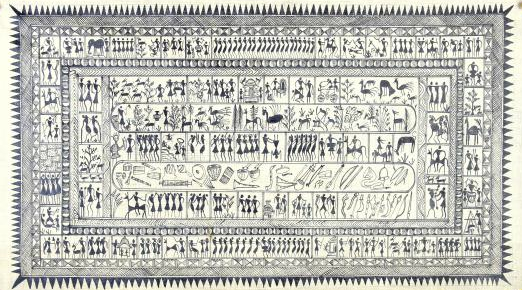Anu Ramdas

Sometime back, I was looking for the translation of the Oriya Mahabharata written by the Shudra saint-poet Saraladasa. Eager to post an excerpt centered on Sarala’s Ganga on The Shared Mirror, I was busy combining library and internet searches, when I got sidetracked by a poem penned by none other than the brahmin poet, Banabhatta.
I am now in love with this brahmin poet.
No, not really, but I was far from bored with what I found, as I usually am with brahmanized/mainstream literature. Though the poem contains no mention of caste, it still is fascinating stuff. Such rare articulation, beautifully illuminating the fear and anxiety of the colonizer, with just a few lyrical lines, Bana develops a blueprint for the demonization of the natives; a textual instrument for his descendants to perpetually fine-tune. For, colonization rarely means the extinction of the colonized, it usually means the complex business of having the native remain in a constant state as the ‘other’. And caste is all about the other, isn’t it?
When race and geography of the oppressor and oppressed are not clearly distinct, where and how do we begin locating the processes of internal colonization? Perhaps in the narratives of both sides (?).
In Harshcharitra and Kadambari, Bana makes it abundantly clear that he writes from a brahmin centric worldview. In the introductions to both the non-fiction and fictional work, he traces his impeccable brahmin lineage back to some typically non-human, heavenly origin. Now, let us check out how Bana creates the ‘other’ in one particular tract of Kadambari. The verses below form a part of the scene depicting a face-off between the Savara and Bana’s ‘civilized’ heroes as they trespassed deep into the jungles. There is sufficient verifiable proof that the Savara people are one of the earliest inhabitants of this land. Thus in this poem, we are looking at a brahmin’s view of the Savaras. For a writer illustrating the ‘other’ is easiest done in a battle scene, in one neat move, you ensure your readers know whom to fear, despise, and hate. It is a literary device as old as storytelling itself. Bana gives us a background of the ‘enemy’, the careful details he offers, as descriptors of the Savara’s way of life would make trained anthropologists sit up and take notice. Here is how Bana begins the description of the Savara:
Oh, they lived a life devoid of knowledge
Their life is condemned by wise men
They eat the flesh, honey, which is forbidden
in the civilized society
//
Perfect screenwriting material!
Line 1: state the enemy is without the single most potent weapon of humankind -knowledge!
Line 2: substantiate it with condemnation by a third party, no proof or reason for condemnation required. Third-party need not have a name or claim to neutrality, just tag a ‘wise’, and that should do.
Line 3: is crucial, list the dietary difference, and firmly establish the ‘other’ for all times to come, dietary hatred is fail-proof, works like gravity, it is elemental for the maintenance of the self from the other. Bana, the brahmin poet is spot on and on the roll.
Take home message for the readers from the above verse: victory is clear and easy for Bana’s heroes; we are dealing with ‘knowledge-less beings!’ The poet has primed us for further elaboration of qualities that has only one way to proceed, a downward spiral with lesser and lesser human-like traits.
Their physical exercise is hunting
Their intelligence lies in understanding
The nature of the birds
Their inmates are dogs
Their kingdom is the lonely forest. (1)
//
Now is this going downwards or upwards? This verse tickled my funny bone a bit, there must be some ‘politically correct’ brahminized souls squirming at this or maybe not. Don’t worry, sweethearts, this is Bana during premodern times, let’s cut him some slack, he is clueless about the green movement, specialized disciplines like ornithology or complex multidisciplinary subjects like environmental science were still unborn, and pet cultures were yet to kick start the multi-million dollar industry of our times. Instead, let us focus on his utterly lovely insight in line 9: “Their kingdom is the lonely forest!” And what follows.
They live with cruel animals like the tiger
(hence they are cruel)
They propitiate their Gods with the
animal blood
Theft is their life
Their ornaments are the jewels of the Cobra. (1)
These are self-explanatory verses to anyone who is slightly familiar with histories of the colonizer’s fear of the natives and their lifestyles, their capacities, their knowledge of the local environment, which is desperately sought by the colonizer. The forest is lonely, but, it is a Kingdom!
Then, Bana, the brahmin poet emerges as a global patriarch and presents his observation of the gender relations of the Savaras’ of his time.
Their wives are those women who have been captured.
They had been wives of others. (1)
Bana doesn’t seem to require too many words to convey his contempt here, in just two lines one gets the full force of the impurity he associates with women who have been wives of others and the men who are accepting of this. As to the capturing part, the Internet goddess will find for interested readers other possibilities: the Savara people permit elopement of men and women, both married and unmarried, second marriages are commonplace for men and women (2). A pregnant woman opting out of her first marriage and seeking a second husband causes no earth-shattering upheavals; the child is welcomed into the new family.
The Savara men seemed to go against the universal model of patriarchy -which spins around the barely controlled male fear of all things female. Bana of course cannot be held responsible for his brahiminical heritage; his twice-born status itself revolves around the very issue of womb control. The ceremony of upanayana is given this interesting reading by some historians:
On the basis of brahminical literature, that attempts were made to structure biological reproduction and locate it within a specific social context. On the one hand, legitimate reproduction was linked to marriage. What is more, the wife was constructed as an instrument of procreation with her procreative powers being appropriated through a variety of rituals. As such, she was expected to participate in procreation but her claims to the offsprings produced was subordinated to those of her husband. As an extension of this, children, especially sons, were ritually connected to the fathers and vice versa. Besides, rituals, mantras and learning were often depicted as being superior means of producing offsprings, as opposed to the physical process of copulation. This was reinforced by portraying related processes such as menstruation and childbirth as polluting. In a sense, this culminated in the privileging of the upanayana or initiation, which was regarded as a second, spiritual birth. This was viewed as better than the first, physical birth. (3)
Describing non-brahmin men and women calls for acknowledging and reinforcing too many kinds of pollutions for Bana.
Women from non-brahmin communities who constantly resist assimilation have to keep unearthing and examining such contrasting narratives to deconstruct internal colonization using multiple sources, textual and non-textual.
Ikon, the painted narratives
Though Bana seems quite knowledgeable about the Savara I am not quite sure if Bana comments on their ikon-decorated homes elsewhere.(4) What would those paintings mean to him? Lives lived without knowledge cannot be presumed to create encrypted knowledge bytes as pictographic art. Perhaps Bana believed the written word would persist long after the Savara art was erased from memory. Or more simply that the knowledge symbolized in the Savara art would not be interpreted as easily as written texts. In which case I would agree whole-heartedly.
Asking the question, do we possess any skills to interpret the narratives embedded in this art form would be moot – we, being the products of the brahminized education system cannot come by learned skills to understand the non-brahminical heritages, right?
What about the default alternative, wear the Western lens and imagine Kant’s possible take on this art, or Marx’s possible comment on the images of humans engaged in production and the kind of social order it presents, or what Audre Lorde may have to say for images of men and women represented as equal statured? What about my own training and engagement with encrypting information about natural science for machine readability? Can I begin decoding the codes of wisdom about natural science visible as stylized symbols to the most casual observer of a Savara painting?
These are pictorial representations of reality, flora, fauna, humans, and their activities. To be able to perceive the symbolism within them calls for a profound understanding of the history of mankind, possess critical knowledge of changing environments and natural diversity; be able to fathom the temporality of breathing life as it exists between non-living and the living, the real and mythic worlds. And appreciate the origins and continuation of recording science and technology, pictographically.
We have to unpeel too many layers to begin an organic interpretation of an Ikon or the various other non-textual narratives of the non-brahminical world. Tough job, indeed!
Give me a brahmin poet’s representation of reality, anytime, it is a lark for me to decode.
Likewise, imagine Banabhatta in modern times, being given an Ikon painting and see what he makes of it. Hopefully, he factors in the women’s movement and all other ‘modern’ realities that appear implicitly in the ancient practice of Ikon painting by the Savara.
This post is not to re-state the simple formulation of seeking the simultaneous examination of brahminized and non-brahmin narratives, but for us to enjoy doing it. Poetry and painting, text and orality, dirges, and slokas -narratives that are different in formats can be used to aid us as we go about countering processes of internal colonization. One format might seem as easy as snapping a dry twig, like Bana’s poem here, the other may be a hard nut to crack, like the Ikon. We have to find creative ways of extracting the embedded information in them for reuse and to redeploy in novel ways. This is not to go seeking a primordial, ideal social order, but to bring back liberating aspects that have been buried under the brahmin’s notions of shame, ignorance, or knowledge. Unpacking and contrasting these narratives will set us, the women resisting brahminization, free to imagine a world that does not fetish on female sexuality. A world with men not crippled with the desperate need to solely own and control the wombs of their wives. A world where young men are raised to partner with the woman’s mind and body with confidence, instead of fear. And young women are raised to partner with the man’s nurturing characteristics with confidence, instead of guilt. Where the inhuman and ugly caste hierarchies dissolve. Where men and women have equal resources, time, and space to dream, and follow dreams.
This article was first published in April 2011 on ‘Writing Caste’, now defunct blog.
~
Sources
1) Tribal roots of Hinduism. Shiv Kumar Tewari
2) Savara, an ethnographic profile
3) Women in early Indian societies. Ed. by Kumkum Roy.
4) The Sauras and their panoramic paintings. C. B Patel
5) Image: courtesy Internet.
Note: The wall paintings of Sauras called ikon or italons.
~~~
Anu Ramdas is a founder Editor of Round Table India.










